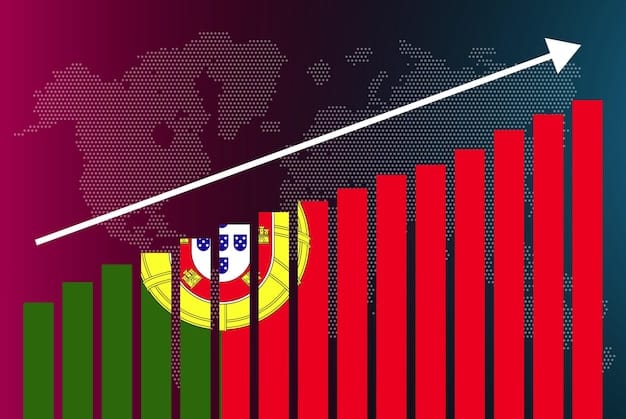US-Peru Trade Agreement: Impact on Peruvian-American Businesses

The Impact of the New US-Peru Trade Agreement on Peruvian-American Businesses: Insider Insights reveals new opportunities and challenges, affecting sectors from agriculture to technology and fostering bi-national investment while potentially increasing competition for local businesses.
The US-Peru Trade Agreement has been a cornerstone of economic relations, and recent developments continue to shape the landscape for Peruvian-American businesses. Understanding the impact of the New US-Peru Trade Agreement on Peruvian-American Businesses: Insider Insights is crucial for entrepreneurs and investors looking to navigate this evolving environment.
Understanding the US-Peru Trade Agreement Basics
The US-Peru Trade Promotion Agreement (TPA), implemented in 2009, established a framework for reducing barriers to trade and investment between the United States and Peru. It’s important for Peruvian-American businesses to understand its implications.
This agreement covers a wide range of issues, including tariffs, intellectual property rights, and investment regulations, aiming to foster a more open and predictable business environment.
Key Provisions of the Agreement
Several provisions within the agreement are particularly relevant, impacting various sectors and business activities.
- Tariff Reductions: Gradual elimination of tariffs on a wide range of goods.
- Intellectual Property Protection: Enhanced protection for patents, trademarks, and copyrights.
- Investment Protections: Guarantees of fair and equitable treatment for investors.
For many Peruvian-American businesses, these provisions can have tangible effects, whether through reduced import costs or enhanced protection for their innovations.
In summary, the US-Peru Trade Promotion Agreement provides a structured framework designed to facilitate trade and investment between the two nations, offering both opportunities and challenges for Peruvian-American businesses.
Economic Impacts on Peruvian-American Businesses
The trade agreement between the US and Peru has had multifaceted economic effects, leading to an increase in trade volume and shifts in the patterns of commerce influencing Peruvian-American businesses.
Analyzing economic indicators and specific business examples reveals how well Peruvian-American firms can leverage strategic provisions embedded in the agreement to enhance their positions in the market.

Increased Trade Volumes
The TPA has led to noticeable surges in the volume of trade between the United States and Peru, contributing significantly to revenue opportunities for companies on both sides.
- Agricultural Sector: Increased exports of Peruvian agricultural products to the US market.
- Textile Industry: Enhanced competitiveness for Peruvian textile manufacturers.
- Technology Services: Expanded opportunities for US tech companies in Peru.
These shifts have created a dynamic trade ecosystem, where opportunities and challenges intertwine, shaping how Peruvian-American companies operate and strategize.
In conclusion, the economic impacts on Peruvian-American businesses from the trade agreement have been significant, driving both opportunities and challenges.
Navigating Challenges in the New Trade Landscape
While the US-Peru Trade Agreement offers significant benefits, it also presents challenges for Peruvian-American businesses that require adaptive strategies and informed decision-making.
Understanding potential pitfalls and implementing best practices can help these businesses mitigate risks and thrive in a competitive environment by finding solutions.
Increased Competition
One of the primary challenges is heightened competition, both in the United States and Peru, as businesses from both countries gain easier access to each other’s markets. This can happen because of multiple reasons.
Peruvian-American small businesses may find it difficult to compete with larger, more established firms from the US, thereby affecting the ability to compete with larger businesses.
- Strategic Differentiation: Focusing on niche markets and value-added services
- Operational Efficiency: Streamlining processes to reduce costs
- Market Adaptability: Remaining flexible and responsive to changing market conditions
These strategies require careful planning, resource allocation, and ongoing evaluation to ensure they remain effective.
Navigating the challenges in the new trade landscape requires agility, strategic thinking, and a proactive approach to risk management.
Opportunities for Bi-National Investment
The trade agreement facilitates cross-border investments, paving the way for Peruvian-American-owned businesses to tap into new markets and diversify their operations.
Exploring the potential of bi-national investment involves assessing market conditions, legal frameworks, and available incentives to ensure strategic and profitable ventures.

Incentives and Support
Both the United States and Peru offer diverse incentives and support programs designed to encourage foreign investment. These may change overtime.
- Tax Incentives: Reduced tax rates or tax exemptions for certain investments
- Grants and Subsidies: Financial assistance for specific projects or industries
- Technical Assistance: Support services for business planning and market entry
Identifying and leveraging these incentives can significantly reduce the costs and risks associated with bi-national investment.
Bi-national investment offers vast potential for Peruvian-American businesses to scale their operations, diversify their markets, and contribute to economic growth in both countries.
Sector-Specific Impacts and Insights
The impact of the agreement varies considerably across different sectors, requiring businesses to understand nuanced dynamics and tailor their strategies accordingly. This impact is not equal or consistent.
A sector-specific analysis provides valuable insights into emerging trends and the challenges and opportunities that Peruvian-American firms encounter in their respective industries.
Agriculture, Textiles, and Technology
Certain sectors have displayed notable reactions to the trade agreement, shaping the commercial engagement between the U.S. and Peru. Learning how it interacts can be beneficial.
The agreement boosted agricultural exports from Peru to the U.S., while the textile industry saw both increased competition and enhanced export prospects.
- Technology Innovation: Supporting the development and adoption of new technologies.
- Sustainable Practices: Promoting environmentally friendly and socially responsible business models.
- Market Research: Conducting thorough analysis to identify emerging trends and consumer preferences.
By focusing on these strategies, Peruvian-American businesses can stay ahead of the curve and maintain a competitive edge.
Sector-specific impacts and insights provide a granular view of the trade agreement’s effects, enabling Peruvian-American businesses to make informed decisions and capitalize on unique industry opportunities.
Future Trends and Predictions
Anticipating future trends and making informed predictions is crucial for Peruvian-American businesses aiming to sustain long-term success in the evolving trade landscape that we all live in.
Monitoring geopolitical developments, technological advancements, and evolving consumer preferences can help businesses proactively adapt to change and seize emerging opportunities.
Sustainable Trade Practices
The increasing emphasis on sustainability is one of the key trends affecting global trade. Incorporating environmental and social responsibility into business operations in important.
Consumers are increasingly demanding products and services that are ethically sourced and environmentally friendly, and businesses that prioritize sustainability are likely to gain a competitive advantage and improve customer satisfaction.
- Digital Transformation: Automating processes and using data analytics and artificial intelligence.
- E-Commerce Expansion: Leveraging online platforms to reach new markets and customers.
- Supply Chain Resilience: Building robust and flexible supply chains that can withstand disruptions.
By embracing these strategies, Peruvian-American businesses can prepare for the future and thrive in an increasingly competitive and uncertain global market.
In conclusion, anticipating future trends and making informed predictions requires vigilance, adaptability, and a commitment to continuous learning and innovation.
| Key Point | Brief Description |
|---|---|
| 📈 Increased Trade | The trade agreement has led to higher trade volumes between the US and Peru. |
| 🤝 Bi-National Investment | Opportunities for US-Peruvian businesses to invest in both countries. |
| 🌱 Sustainable Practices | Emphasis on incorporating environmental and social responsibility. |
| 💻 Digital Transformation | Leveraging technology to transform and automate processes. |
Frequently Asked Questions
▼
The US-Peru Trade Promotion Agreement (TPA) is a trade pact implemented in 2009, designed to reduce barriers to trade and investment between the United States and Peru. It covers a wide range of issues.
▼
The TPA has led to a notable increase in trade volumes between the United States and Peru, boosting various sectors such as agriculture and textiles, contributing to economic opportunities for both countries.
▼
A primary challenge is increased competition, requiring businesses to innovate and differentiate to thrive. Another challenge is to remain up to date with changing compliance requirements.
▼
Bi-national investment allows Peruvian-American businesses to diversify markets, tap into new resources, and expand operations in both countries, leading to enhanced growth and profitability.
▼
Businesses should focus on sustainable practices, digital transformation, and building resilient supply chains. These strategies can help them adapt to changing market conditions and gain a competitive advantage.
Conclusion
Navigating the complexities and opportunities presented by the US-Peru Trade Agreement requires strategic insight and proactive adaptation. By understanding the agreement’s nuances, addressing challenges, and capitalizing on emerging trends, Peruvian-American businesses can unlock significant potential for growth and success in both the US and Peru.





